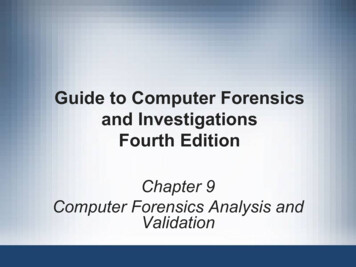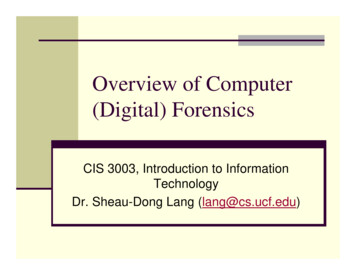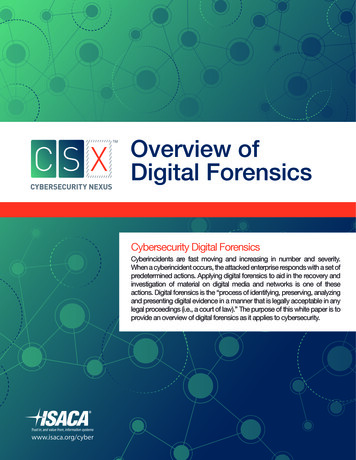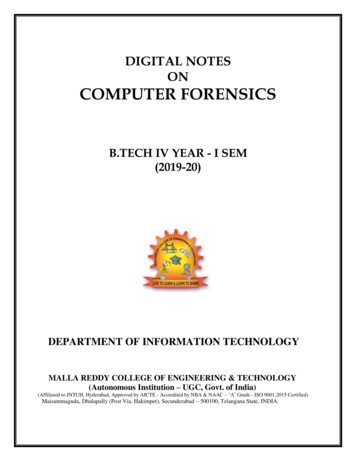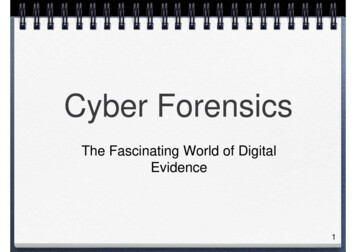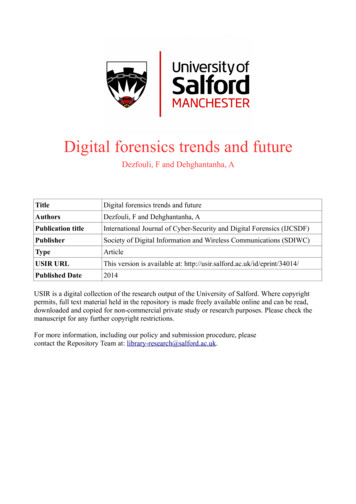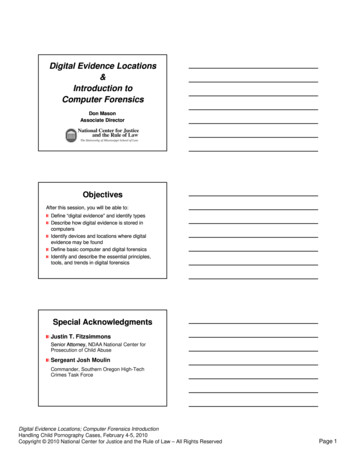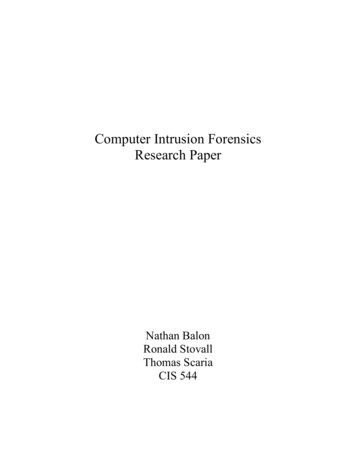
Transcription
Computer Intrusion ForensicsResearch PaperNathan BalonRonald StovallThomas ScariaCIS 544
AbstractThe need for computer intrusion forensics arises from the alarming increase in thenumber of computer crimes that are committed annually. After a computer system hasbeen breached and an intrusion has been detected, there is a need for a computer forensicsinvestigation to follow.Computer forensics is used to bring to justice, those responsible for conducting attacks oncomputer systems throughout the world. Because of this the law must be follow preciselywhen conducting a forensics investigation. It is not enough to simple know an attacker isresponsible for the crime, the forensics investigation must be carried out in a precisemanner that will produce evidence that is amicable in a court room. For computerintrusion forensics many methodologies have been designed to be used when conductingan investigation. A computer forensics investigator also needs certain skills to conductthe investigation. Along with this, the computer forensics investigator must be equippedwith an array of software tools.With the birth of the Internet and networks, the computer intrusion has never been assignificant as it is now. There are different preventive measures available, such as accesscontrol and authentication, to attempt to prevent intruders. Intrusion detection systems(IDS) are developed to detect an intrusion as it occurs, and to execute countermeasureswhen detected. Intrusion detection (ID) takes over where preventive security fails. Inorder to choose the best IDS for a given system, one should be aware of the advantagesand disadvantages of the each IDS. This paper views a forensic application within theframework of Intrusion Detection and details the advantages and disadvantages of eachIDS.IntroductionIn a perfect world the need for determining the activity conducted on a network or withina computer would not be necessary; however, this is not a perfect world and there aretimes when it is imperative that the activity of a computer be monitored. There should bea way for an individual to observe assets, such a computer or network, in times whenpossible intrusion or misconduct has occurred. For this reason, computer forensics, anewly developed area of computer science, becomes an increasingly more importantaspect daily and will be widely used in the twenty-first century.The widespread use of computers has caused computer crimes to increase at an alarmingrate. Computers have given criminals a new approach to carrying out their misdeeds.After a crime or a questionable act is detected on a computer, a digital investigation mustfollow. The investigation is used to determine the scope of the problem. The computersinvestigated will typically be either those used to commit the crime or those which are thetargets of the crime.During the Enron incident a great deal of paper was shredded to avoid leaving evidenceof a wrong-doing. However computer forensic investigators were able to recover a large1
extent of the information in electronic form [Salkever 2002]. In computer forensics, acase may be as simple as to determine whether or not an employee is engaging inimproper activity on the network; or it can be as severe as determining where a majorattack originated from, such as the SOBIG virus. For these reasons, computer intrusionforensics is an emerging field of essential research.Intrusion forensics is a specific area of Computer forensics, applied to computer intrusionactivities. Computer forensics, which relates to the investigation of situations wherethere is computer-based (digital) or electronic evidence of a crime or suspicious behavior,but the crime or behavior may be of any type, quite possibly not otherwise involvingcomputers. Where as Intrusion forensics relates to the investigation of attacks orsuspicious behavior directed against computers per se [Mohay et al. 2003]. Intrusiondetection uses standard computer logs and computer audit trails, gathered by hostcomputers, and/or information gathered at communication routers and switches, in orderto detect and identify intrusions into a computer system. Successful detection ofintrusion is based either upon recognition of a known exploitation of a knownvulnerability or upon recognition of unusual or anomalous behavior patterns or acombination of the two.Computer forensics on the other hand is concerned with the analysis of any informationstored by, transmitted by or derived from a computer system in order to reason post hocabout the validity of hypotheses that attempt to explain the circumstances of an activityunder investigation. Computer forensics therefore, covers a much broader scope ofactivities than does intrusion detection, the scope of the latter being limited to reasoningabout activities or detecting activities relating to computer system abuse.Literature Review and Problem DefinitionLiterature ReviewComputer forensics is a relatively new field of study. At the current time, there are alimited number of books published on this topic. A search on Amazon.com resulted in afinding of 15 to 20 books on the subject. Computer Forensics: Incident ResponseEssentials by Kruse II. and Heiser is a entry level book in this new field. The bookdefines computer forensics and the steps used to conduct a forensics investigation.Another book, Know Your Enemy by the Honeynet Project, looks at the tools andmethods of the blackhat, hacker community. The Honeynet Project used intrusiondetection systems and computer forensics to analyze the attacks of hackers in an effort tolearn the motivations and skills of hackers. An informative book focusing on the subjectof intrusion detection is Network Intrusion Detection, by Stephen Northcutt and JudyNovak.A great deal of the material reviewed on computer forensics came from web sites. Onlinemagazines, such as Dr. Dobbs, securitymanagement.com, sercurityfocus.com, andscmagazine.com, these sites regularly post articles on security and computer forensics.Also, the Department of Justice publishes information on their web site for conducting a2
computer forensics investigation. There also many commercial web site for companiesof computer forensic services. The commercial sites give some of the techniques thatthese companies use to conduct investigations.The bulk of the literature found from books and web sites dealt with the basic steps usedto carry out a forensics investigation, such as the ways the logs and hard drives can beexamined to turn up evidence, and the legal ramification of computer forensics. Themajority of quality literature found on the topic of computer forensics came fromprofessional and academic journals. Professional and academic journals offer the mostin-depth look into computer forensics. Some of the topics found in journals were: “AnExamination of Digital Forensic Models”, “Research in Progress: Risks and Solution toProblems Arising from Illegal or Inappropriate On-line Behaviors”, and “ForensicsReadiness”.Problem DefinitionThe field of digital forensics is a relatively new field of study. Many of the techniquesused in computer forensics have not been formally defined. Computer Forensics islooked at as part art and part science [Honeynet Project 2002]. Computer Forensics willevolve into a science as more research and standardized procedures are developed.A survey of the field of computer intrusion forensics will be given in this paper. The goalof this paper is to explain the advantages and disadvantages of computer intrusionforensics. A formal definition of computer forensics will be given. The paper will lookat how intrusion detection systems can be used as a starting point to a computer forensicsinvestigation. Also, the ways to preserve and recover data during a computer forensicsinvestigation will be explored. A discussion of how some of various software tools thatare used in a computer forensics investigation will be included. This paper will explainthe rights granted to a company who plans to implement such tool and will provideinformation on tools currently available for use in computer forensics. Last, the paperwill explore ways that an intrusion detection system can be used in correspondence withcomputer forensics.DiscussionComputer IntrusionThe need for computer intrusion forensics arises from the event that an intrusion into acomputer system has occurred. According to the CERT web site a computer intrusion is,“Any intentional event where an intruder gains access that compromises theconfidentiality, integrity, or the availability of computers, networks, or the data residingon them.” According William Stallings book Cryptography and Network Security,intruders can be classified into three types [Stallings 2003]: Masquerader: An individual who is not authorized to use the computer and whopenetrates a system’s access controls to exploit a legitimate user account.3
Misfeasor: A legitimate user who accesses data, programs, or resources for which suchaccess is not authorized, or who is authorized for such access but misuses his or herprivileges.Clandestine user: An individual who seizes supervisory control of the system and usesthis control to evade auditing and access controls or to suppress audit collection.The amount of damage done by an intruder to a system can vary greatly. Some intrudersare malicious in nature and others are just curious and want to explore what is on a localnetwork. Computer users must protect themselves from intrusion. While there are no100% effective methods of eliminating intruders completely, some methods must be usedto reduce intrusions. In the event that an intrusion has taken place the last line of defenseis an intrusion detection system. An intrusion detection system can alert the systemadministrator in the event that the system has been breeched. Once the intrusiondetection system has detected an event, an intrusion forensics investigation should beconducted to note the extent of the intrusion and any damages that may have occurredand to locate the source of the attack.Computer ForensicsComputer forensics involves the preservation, identification, extraction, documentationand interpretation of computer data [Kruse II and Heiser 2002]. Computer forensics isusually used when a crime has been committed or an inappropriate activity has takenplace. Some common examples of when computer forensics is used are: Identity theft, such as stolen credit cards numbers and social security numbers.To reveal if trade secrets were stolen from an organization.Investigate a hackers attack on a computer system.Finding evidence of child pornography.For divorce proceedings, evidence of a cheating spouse.These are just a few examples of when computer forensics may be used. There arenumerous other times when computer forensics can be employed.Computer forensics involves many common investigative techniques used by lawenforcement. The only difference is they are used on digital media [Wright 2001]. Themain goal of a computer forensics investigation usually involves a conviction in eithercriminal or civil court. During an investigation, procedures must be followed preciselyso evidence is amicable in court. Great care must be taken in the preservation andrecovery of data.Computer Forensics InvestigatorA computer forensics investigator is a person who conducts an investigation on thedigital media. A computer forensics investigator must be a well-rounded individual. It isnot enough for the investigator to have only a strong knowledge about computers. Theinvestigator must have knowledge in many other areas. The following are some of theskills needed in computer forensics [Broucek 2002]:4
Computer Science: knowledge of operating systems, programming languages, andcomputer securityLaw: computer, criminal and civilInformation System: system management, system policies, and user trainingSocial Science: socio-political issues, socio-psychological impact of computers, andhacktivismTo conduct a computer forensics investigation, the individual must have a strongbackground in computer science. The investigator should know many different operatingsystems work. The two most common systems to investigate are Windows and UNIX.Knowing these two operating systems is a must. It is possible that other types of systemswill also have to be investigated besides UNIX or Windows. Next, the investigatorsshould know a wide range of programming language such as C, C , UNIX scripts andothers. Many times the source code is changed on the investigated system, so theinvestigator must know what the changes to code accomplish. Last, the investigatorshould be up to date on computer security issues. They should know what newvulnerabilities exist that hackers are using to exploit systems.The computer forensics investigator must be familiar with the laws of state and countrythey are working in. The investigator needs to know the correct techniques for documentevidence to be used in a legal proceeding. The forensics investigator will need to thenpresent the evidence they found in court as an expert witness if evidence of a crime isfound.The next area that an investigator needs to be knowledgeable in is information systems.The investigator should have a deep understanding of information system management.The more he knows about the system policies of an organization, the greater likelihoodthe investigator will find violations of the policy. The investigator should be able to workwell with people. At times the investigator will need to work with and question the endusers in an organization.The investigator should also know about current issues in social science and the impact ofcomputers on personnel privacy. This is an area where the investigator needs to usesensitivity when working with the members of an organization. The investigator shouldalso be able to understand the thinking of the hacker community. These are a few of thesocial issues that an investigator must deal with.The Legal Methods of Computer ForensicsThe definition of Computer Forensics has already been discussed in the previous section.To recap, Computer Forensics involves the preservation, identification, extraction,documentation and interpretation of computer data [Kruse II and Heiser 2002]. Thisdefinition will be modified to suit the needs of this section. Lets assume that instead ofattempting to preserve information on a machine, the asset may have been compromisedby an unknown assailant. The method of solving the attack would be to use computerforensics, but now we are using said information for legal issues. Computer Forensics can5
further be defined as the application of computer investigation and analysis techniques inthe interest of determining potential evidence, which might be sought in a wide range ofcomputer crime, or misuse, including but not limited to theft of trade secrets, theft ordestruction of intellectual property, and fraud [Robbins 1999]. This section will describethe legal aspects of the new definition and explain the rights that employers andinvestigators have when it pertains to forensics on an asset such as the computer.When an investigation develops to a point where information may need to be retrievedfrom an asset such as a computer there are a lot of issues to take into consideration. Theevidence has to remain valid through the course of the investigation to be admitted into acourt of law. The investigators must also make sure that search and seizure of the asset isallowed, otherwise the investigation can be corrupted.The following case provides a sufficient example the legal rights involved in computerforensics. In the winter of 1999, during contract negotiations, a Northwest Airlines flightattendant hosted a message board on his personal website; among the messages wereanonymous messages by Northwest employees urging co-workers to participate in sickouts, which is illegal by U.S. federal labor laws. That season over 300 flights werecancelled. Northwest Airlines subsequently obtained permission from a federal judge tosearch union office computers and employee personal computers, in order to obtain theidentities of the anonymous posters [Caloyannides 2001]. Note that the employer wasgranted the right to view not only the office computer, but the personal ones as well. Thequestion on the table is how can that be possible? One may argue that the constitutionprohibits such actions and that the accused should have had some form of legal protectionagainst such an intensive search. The fact is that it is the exact opposite.Fourth AmendmentHere is the fourth amendment to the constitution, “The right of the people to be secure intheir persons, houses, papers, and effects, against unreasonable searches and seizures,shall not be violated, and no Warrants shall be issued, but upon probable cause,supported by oath or affirmation, and particularly describing the place to be searched, andthe persons or things to be seized. Draper v. US (1959) has legally defined probablecause as "where known facts and circumstances, of a reasonably trustworthy nature, aresufficient to justify a man of reasonable caution or prudence in the belief that a crime hasbeen or is being committed" [O’Conner 2002]. Accordingly, as long as a plaintiff canconvince a judge of probable cause, a warrant to search a computer can be granted.Today, more federal judges are approving searches of computers for evidence in civil andcriminal cases [McCarthy 2000].ENRONA recent case that is under investigation is the ENRON bankruptcy incident. Thecompany was a multi-billion dollar organization that marketed electricity and natural gas,delivered energy, and provided financial and risk management services to people aroundthe world. In the year 2000, ENRON had revenues of over 100 billion dollars [Parkerand Waichman 2002]. In December of 2001, ENRON’s stock fell to fifty cents a share.Thousands of employees lost their jobs. By January of 2002, a federal investigation was6
initiated on ENRON to determine whether or not fraud caused the fall of the company[Parker and Waichman 2002].Computer Forensics would play a pivotal part in this investigation. While companies goout of business quite frequently during the current state of the economy, it is very odd fora multi-billion dollar company to loose everything in a year’s timeframe. Let us assumethe asset is the computers within ENRON, but more importantly any files that weredeleted that would lead to evidence of fraud. Recall that information deleted on amachine is not always completely erased; it is rather inaccessible to the user. Due to thewidespread panic this incident has caused among employees and stockholders, it ispossible for computer forensics experts to investigate.SOBIG VirusThe case of the SOBIG blaster worm virus that clogged the networks of systems acrossAmerica in an attempt launch a full-scale assault on the Microsoft Corporation is anotherinstance where computer forensics was employed. During the reign of this virus, it wasestimated that the number of infected machines were in the hundreds of thousands. Thesolution was not as simple as downloading a patch because there was not enoughbandwidth available to do so [Fisher 2003]. On Friday, August 29th, 2003, federal agentsarrested 18-year-old Jeffrey Lee Parson for intentionally damaging a computer, aviolation of U.S. criminal code [Hachman 2003].This investigation also warrants the use of computer forensics. The probable cause forthis case would be the millions of dollars lost due to network shutdowns and lost work.The same would be the case for the majority of the exploitation viruses that are out there.Many of these hackers feel a sense of security in that they assume their actions cannot betracked and believe that their personal computer cannot be searched. This is not the casein this scenario. This particular virus was broadcasting out on the Internet instead of thetraditional method, via email. Under this circumstance, it is imperative that computerforensics be used in this matter. The assets in this scenario would the number ofcomputers affected by this virus, the vulnerability is the Microsoft Vulnerability that wasdiscovered by the attacker, and the threat is the virus clogging the bandwidth of thenetworks, producing a denial of service attack, which results in a lack of productivity tomillions of computer users.Legal RightsThese two cases are brought up to provide examples of where Computer Forensics isnecessary. The probable cause has already been identified, and it is now time to definethe legal procedures necessary to maintain the evidence for a court of law. Thisprocedure will work for government investigations as well as employer searches. Theone thing to remember is that as long as there is probable cause a search warrant can beissued and computer forensics can take place. Employers must be careful when searchingthrough an employees work area. While government employees are bound to the fourthamendment, employers need to identify the reason the search is work-related. Therefore,items such as briefcases, purses, and gym bags are still off limits to employer searches[Cybercrime 2001].7
Seizing ComputersInvestigators must be specific when seizing hardware for investigation. Under normalcircumstances the employee’s/attacker’s computer (desktop, monitor, keyboard, andmouse) would be collected; however, in the networking age the computer in questionmay be just a dummy terminal and all the potentially hazardous information hidden onthe server or dispersed throughout the network [Cybercrime 2001]. It is imperative thatthe first step is specific in what should be gathered and only hardware that will notcripple the network of the company is taken.Once the appropriate hardware has been marked for seizure, it is important to transport itin the proper fashion. For most computer forensics investigations, the personal computeris a standard desktop with a monitor, keyboard, and mouse; however, more complexsystems must be handled in a special way. Here is that list of transport guidelines: Agents are to protect the hardware from damageDisassembly of hardware must be done in such a way so that reassembly can occurwithout damaging the hardware.Photograph the area where the hardware is before disassembly and prepare a wiringdiagram. Any inconsistencies could result in tainted evidence.All floppy, magnetic, and removable disk drives must be protected according tomanufacturer standardsAll hardware must be kept in a dust and smoke free environment with the temperature setbetween 40 – 90 degrees Fahrenheit [Cybercrime 1999].The proper procedures must be followed with the forensics team in possession of theconfiscated computer equipment. The computer seized must be stored properly at alltimes. A chain evidence of custody must be in place. The chain of custody documentswho has custody of the evidence at all times [Crayton 2003]. It is important that theforensics team documents not only who has the equipment, but also for what length oftime and when it was returned to storage. Also, the investigator should documentanything done with the evidence. For example, if the investigator runs a program tosearch for key words on a hard drive it should be added to a log. The log should containthe name of the command that was run, the time it was run, and the results.Once the hardware has been retrieved properly, it can be searched using the forensicstools that are available. The Recycling bin, hidden folders, and log files would be thefirst spots to search for information on the computer. If data is suspected to have beendeleted, then the solution would be to use a data retrieval tool to find the data in one ofthe hidden sectors of the storage medium. It is important that the machine underinvestigation be copied using a GHOST utility so if a mistake should occur, it is alwayspossible to return the original configuration. While this is a big aspect of ComputerForensics, it is not the only one. There are other uses for this science and it will bediscussed in the other sections of this paper.8
Computer Forensics MethodologiesDuring a computer forensics investigation there are a variety of steps that must be taken.The following steps, defined in the book Computer Forensics: Incidence Response, formthe basis for conducting a forensics investigation. Each of these steps can be furtherrefined.1.2.3.4.Acquire the EvidenceAuthenticate the EvidenceAnalysis the EvidencePresent the EvidenceAlong with this methodology developed by Kruse II and Heiser, other more formalmethodologies have been developed. These methodologies have been established to aidin the proper sequence of actions taken in an investigation. Some of the methodologiesare abstract and can be used in any situation which concerns digital evidence and othersare aimed at a certain implementation.The paper “An Examination of Digital Forensics Models” gives five methodologies thatcan be used for digital forensics. The first methodology was established by Farmer andVenema and is targeted towards the UNIX operating system. Second, Mandia andProsise established an incidence response methodology. Third, the US Department ofJustice created a digital forensics mythology which is more abstract then the first twomethodologies and hence could be applied to a wider range of platforms. The DOJMethodology has four phases “collection, examination, analysis and reporting”. Fourth,The Digital Forensics Research Workshop developed a framework based on academicwork. It consists of the stages “identification, preservation, collection, examination,analysis, presentation and decision”. Last, the authors of the paper created an abstractmodel for digital forensics. The abstract model consists of nine phases “identification,preparation, approach strategy, preservation, collection, examination, analysis,presentation, and returning evidence”.Each of the methodologies described above has its benefits and drawbacks. For example,the benefit of the abstract model is that it can be used in any situation where digitalevidence is involved, not just for examining computers. The disadvantage of using anabstract model is the processes may not be defined as precisely. In some cases when aproblem is well defined it may be beneficial to use a non-abstract model. So wheninvestigating a UNIX system, the Farmer and Venema model may suffice compared to anabstract methodology.Computer Forensics and Security PoliciesAn organization should build their security policy around the event that it is inevitablethat computer forensics will be needed in the future. If an enterprise has a plan in placefor when an intrusion takes places, it will greatly aid the organization into the forensicsprocess. All employees of an organization should be trained on what to do in the event of9
an intrusion. Failing to provide employees with training and written procedures canjeopardize a computer forensics investigation. For instance, an employee may think he isaiding in helping to contain an incident and in actuality may be damaging evidence.Along with the typical computer user of the organization, system administrator shouldalso be train. While the system administrator knows a great deal about their system, theymay not have the proper training of what to do in the event the computer forensics isneeded. For these reason the security policy of an organization should contain what todo in the event that computer forensics is needed.Intrusion Detection SystemsComputer crime arising from computer misuse often manifests itself as anomalousbehavior, both of individual systems users and of the system as whole. Althoughimprovements to operating system security continue, the available computer securityfeatures are still not good enough to detect many anomalous behavior patterns by systemusers. Intrusion detection uses standard logs and computer audit trails, gathered routinelyby host computers, and /or information gathered at communication routers and switches,in order to detect and identify intrusions into a computer system. There are many formsof intrusions, they can be divided into two main classes or models that are oftenemployed in IDSs [Mohay et al. 2003]. Misuse intrusions, where well-defined attacks are aimed at known weak points of asystem. Due to the fact that these attacks have been experienced before and are thereforewell defined/documented, very often a purely rule based detection system encapsulatingthe known information about the attack is applied.Anomaly intrusion. These are harder to quantify and are based on observations of normalsystem usage patterns, and detecting deviation from this norm. There are no fixedpatterns that can be monitored and as a result a more “fuzzy approach is often required.Anomaly-based IDS’s uses a typically statistical profile of activity to decide whether theoccurrence of a particular component event or event pattern is normal or anomalous. Ifnormal, then the activity is considered to be harmless and thus legitimate. On the otherhand, if it is anomalous then it is potentially unauthorized and harmful.Signature-based IDS’s attempts to match a sequence of observed events with a knownpattern of events which is characteristic of an attack of some sort, such as a bufferoverflow attack and password guessing. If no match is found with any of the knownattack event patterns (signatures), then the activity under scrutiny is considered to beharmless and thus legitimate. Solely signature-based IDS cannot recognize a new orpreviously unknown type of attack; anomaly-based IDS on the other hand cannotcategorically identify a sequence of events as an attack.In both cases, the IDS reaches a conclusion based upon computed data that is moreinformative than what is allowed by the legal definition of what constitutes computerevidence. This is because the latter is constrained by formal rules of law t
forensics is an emerging field of essential research. Intrusion forensics is a specific area of Computer forensics, applied to computer intrusion activities. Computer forensics, which relates to the investigation of situations where there is computer-based (digital)
